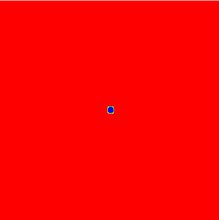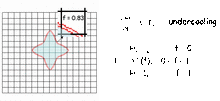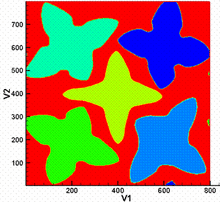Crystal Growth in an Undercooled Melt
 .
. 
A liquid in a square cavity is cooled below its equilibrium solidification temperature. At time t = 0 a solid seed is placed at the center of the cavity. As time increases this seed grows (solidifies). Noise or the natural grid anisotropy will result in preferred growth directions. In these directions growth is accelerated by the stepper temperature gradients and retarded by the decrease of the liquid-solid surface equilibrium temperature--through a sharpening of the surface curvature (Gibbs-Thompson effect). The result is the formation of a dendritic crystal which as it matures will grow at a steady rate.
The above dimensionless simulation (calculated in a 1x1 1/4 domain using a fixed uniform mesh 200x200) inolves a liquid initially under-cooled to -0.8.The growth is controlled by an 8-fold anisotropic surface tension undercooling

where
- k is the curvature of the solid-liquid interface
- q is the angle the outward pointing makes with the x-axis
Following the works by
- K-H. Tacke., Application of finite difference enthalpy methods to dendritic growth, Free Boundary Problems: Theory and Applications (eds. K-H Hofmann, J. Sprekels) Longman Sci. Tech. , Essex, 1990
- K-H. Tacke, A. Harnisch, (1991), Finite difference enthalpy methods for dendritic growth, Proceedings of the International Conference on Computational Modeling of Free and Moving Boundary Problems, WIT press, Southampton, 1991.
- D. Pal, J. Bhattacharya, P. Dutta, S. Chakraborty, An enthalpy model for simulation of dendritic growth, Num. Heat Transfer B, 50, (2006) 59-78.
This crystal growth process can be modelled using an Enthalpy Method which will allow for tracking of the complex growing solid-liquid interface on a fixed sapce grid.
The key to this model is the concept of the diffusive interface model

The key parameter is the liquid fraction. If this is treated as a level set it can be used to calculate the normal and the curvature of the solid-liquid interface

This diffuse interface concept allows us to model the problem in terms of the enthalpy variable
H=T+f
T--dimensionless temperature, f--liquid fraction
Leading to a single domain governing equation

In a time step this equation can be readily solved for the field of nodal H values using an explicit-time stepping routine.
To close the calculation an iterative procedure is required--at each node point--to calculate the nodal temperature and liquid fraction fields.
At nodes where the liquid fraction
0 < f < 1
this iteration requires the calculation of the undercooling DT (see equation above) which through the level set functions above can be calculated in terms of the local liquid fraction field.
Voller and co-wokers have successfully implemented this solution approach for a number of cases, including
- dendrite growth in alloys
- problems with fluid flow and electromagnetic fields
- competitive growth among a number of crystal seeds-see figure

This work is reported in
- V.R. Voller, "An enthalpy method for modeling dendritic growth in a binary alloy", submitted to Int J. Heat Mass Transfer, 2007.
- V.R. Voller, N. Murfield, Application of an enthalpy method for dendritic solidification, Numerical Heat Transfer 2005 (eds. A.J. Nowak, et al) 379-386, Institute of Thermal Technology, Poland, 2005.
- V.R Voller, An enthalpy based scheme for simulating dendritic growth”, Modeling of Casting, Welding and Advanced Solidification Processes-XI, (eds, C_A. Gandin and M. Bellet) 465-472, TMS, Warrendale, 2006.